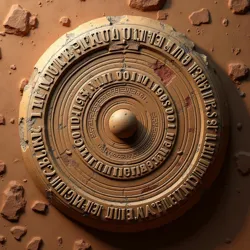Calendar of Two Moons

Ancient calendar stone showing the orbital paths of Phobos and Deimos
Lunisolar calendar
157 A.M.
All Martian nations
Phobos (7.39 hours), Deimos (30.3 hours)
687 Earth days
Great Migration (0 A.M.)
The Calendar of Two Moons (also known as the Martian Standard Calendar) is the primary timekeeping system used across Mars since its formal adoption in 157 A.M. (After Migration). Developed to replace Earth-based calendrical systems, it incorporates the orbital periods of Mars' moons Phobos and Deimos alongside the Martian year to create a complex but precise method of tracking time that reflects the unique astronomical conditions of life on Mars. The calendar represents one of the earliest examples of post-Great Collapse cultural adaptation and remains a fundamental aspect of Martian civilization.
Historical Development
Early Timekeeping Crisis
In the decades following the Great Collapse, Mars' isolated colonies struggled with the inadequacy of Earth-based timekeeping systems. The Earth day-night cycle, months, and yearly calendar proved increasingly irrelevant to life on Mars, where days lasted 24 hours and 37 minutes and years stretched to 687 Earth days. This temporal dissonance created significant challenges for coordinating agricultural cycles, maintaining technological systems, and organizing society.
Standardization Period
 Reconstructed workshop of the early Chronicians showing tools used to track Phobos and Deimos
Reconstructed workshop of the early Chronicians showing tools used to track Phobos and DeimosThe Chronicians of Olympus played a crucial role in developing and implementing the new calendar system. Working from astronomical observations made at the Hellas Impact Basin Observatory, they created a sophisticated mathematical model that incorporated both lunar cycles into a practical timekeeping system. The calendar was formally adopted by the Meridian Confederacy in 157 A.M. and quickly spread to other Martian nations.
Calendar Structure
Lunar Cycles
The calendar's primary innovation lies in its use of both Phobos and Deimos as temporal markers. Phobos, completing an orbit every 7.39 hours, provides the basis for short-term time division, while Deimos' 30.3-hour orbit creates a longer cycle similar to Earth's traditional day. These overlapping cycles create a complex but predictable pattern that has become deeply embedded in Martian cultural practices.
Year Structure
The Martian year is divided into twenty-four periods called "spans," each marked by specific alignments of Phobos and Deimos. These spans roughly correspond to the progression of Mars through its orbit, with additional adjustments made for the planet's axial tilt and its effects on seasonal changes. The Syzygy Masters, an elite group of timekeepers, maintain precise records of these astronomical alignments and their cultural significance.
Cultural Impact
Religious and Social Significance
The Calendar of Two Moons has profoundly influenced Martian society, giving rise to unique festivals and observances tied to specific lunar alignments. The Festival of Crossing Shadows, celebrating rare moments when both moons cast overlapping shadows on the surface, has become one of Mars' most significant cultural events, marked by gatherings and celebrations across different nations.
Agricultural Applications
Martian farmers rely heavily on the calendar for agricultural planning, as it precisely tracks seasonal changes and atmospheric patterns. The Guild of Atmospheric Sciences uses the calendar's spans to predict dust storm seasons and optimal growing periods, while the Aquifer Technocracy coordinates water distribution schedules according to its cycles.
Modern Usage
Digital Integration
Modern Martian society has fully integrated the Calendar of Two Moons into its technological systems. The Sphaerix Framework includes specialized temporal notation for expressing dates and times in the calendar system, while public displays in major cities typically show both lunar positions alongside local time measurements.
International Coordination
The calendar serves as a crucial tool for coordinating activities between different Martian nations. Trade agreements, resource sharing schedules, and diplomatic meetings are all arranged using its standardized system, contributing to its status as one of the few truly universal aspects of Martian civilization.
Technical Aspects
Intercalation Methods
The calendar employs sophisticated intercalation methods to maintain alignment with Mars' orbital period. Additional time units, called "alignment spans," are inserted at calculated intervals based on the precise observation of both lunar orbits. These calculations are maintained and updated by the Universities of Olympus, ensuring the calendar's continued accuracy.
Regional Variations
While the basic structure of the calendar remains consistent across Mars, different regions have developed unique ways of subdividing spans for local purposes. The Frost Kingdoms use additional markers based on aurora patterns, while equatorial regions incorporate measurements of daily shadow lengths into their timekeeping practices.
See Also
- Chronicians of Olympus
- Hellas Impact Basin Observatory
- Sphaerix Framework
- Festival of Crossing Shadows
- Guild of Atmospheric Sciences